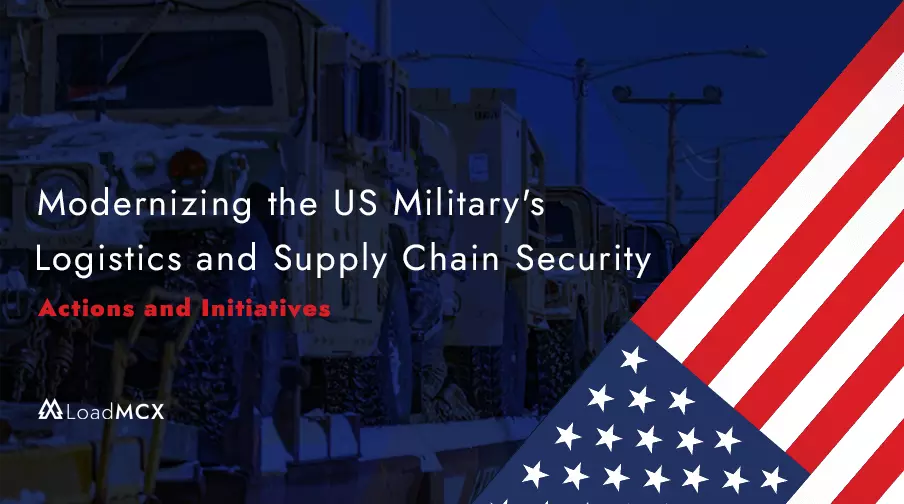The United States military is the most powerful and technologically advanced force in the world. However, in recent years, there has been growing concern about the logistics and supply chain security of the military.

The logistical challenges facing the military are complex, and it is imperative that the military modernizes its logistics and supply chain security to ensure its continued effectiveness.
This article will examine the challenges facing the US military’s logistics and supply chain security and propose actions that can be taken to modernize these critical functions.
Challenges Facing the US Military's
Logistics and Supply Chain Security
The logistics and supply chain security of the US military are facing several challenges that need to be addressed. The following are some of the significant challenges:
-
1
Aging Infrastructure
The US military's logistical infrastructure is aging, and many of the warehouses, depots, and transportation systems are outdated and require modernization.
-
2
Cybersecurity Threats
Cybersecurity threats are a growing concern for the US military. Hackers and state-sponsored actors are constantly trying to exploit vulnerabilities in the military's logistics and supply chain systems.
-
3
Globalization
The US military is increasingly relying on global supply chains to source its equipment and supplies. This increases the complexity of the supply chain and the potential for disruptions.
-
4
Cost
Logistics and supply chain operations can be costly, and the military must find ways to reduce costs while maintaining the necessary levels of readiness.
To modernize the US military's logistics and supply chain security, the following actions should be taken:
-
1
Adopt a Data-Driven Approach
The military should adopt a data-driven approach to logistics and supply chain management. This means using data analytics to optimize the supply chain and identify potential issues before they occur.
-
2
Invest in Technology
The US military must invest in new technologies to modernize its logistics and supply chain systems. This includes technologies such as artificial intelligence, blockchain, and the Internet of Things (IoT).
-
3
Enhance Cybersecurity Measures
The US military must enhance its cybersecurity measures to protect its logistics and supply chain systems from cyber threats. This includes using advanced encryption techniques, firewalls, and intrusion detection systems.
-
4
Increase Collaboration
The US military must increase collaboration with its suppliers and partners to improve the efficiency of its logistics and supply chain systems. This includes sharing data and information to identify potential issues and develop solutions.
-
5
Adopt a Risk Management Approach
The US military should adopt a risk management approach to logistics and supply chain security. This means identifying potential risks and developing strategies to mitigate them.
-
6
Streamline Processes
The US military must streamline its logistics and supply chain processes to reduce costs and increase efficiency. This includes adopting lean principles and eliminating waste in the supply chain.
-
7
Prioritize Sustainability
The US military should prioritize sustainability in its logistics and supply chain operations. This includes reducing its carbon footprint and adopting environmentally friendly practices.
-
8
Develop a Skilled Workforce
The US military must develop a skilled workforce to manage its logistics and supply chain systems. This includes investing in training programs and hiring qualified personnel.
Case Study:
US Military's Logistics and Supply Chain Modernization Efforts
The US military has already taken steps to modernize its logistics and supply chain systems. One notable example is the Defense Logistics Agency’s (DLA) efforts to modernize its inventory management system. The DLA is responsible for managing the military’s inventory of supplies and equipment, and it has been working to modernize its systems to improve efficiency and reduce costs.
The DLA’s modernization efforts include the adoption of advanced data analytics to optimize inventory levels and improve supply chain visibility. The agency has also been investing in new technologies such as robotics and automation to streamline its operations.
Another example of the US military’s logistics and supply chain modernization efforts is the implementation of the Joint Logistics Enterprise (JLEnt). JLEnt is a collaborative effort between the Department of Defense and its partners to improve logistics and supply chain operations. The JLEnt aims to improve the coordination of logistics and supply chain activities across the military services and to standardize processes and systems to increase efficiency.
One of the key components of the JLEnt is the implementation of a single, integrated logistics information system (LIS) that will provide real-time data and analytics to optimize logistics and supply chain operations. The LIS will provide a common operating picture across the military services and their partners, enabling better coordination and collaboration.
The JLEnt also aims to enhance cybersecurity measures to protect logistics and supply chain systems from cyber threats. The initiative includes the implementation of advanced cybersecurity tools and techniques, such as machine learning and artificial intelligence, to detect and respond to cyber attacks.
What We've Learned
The logistics and supply chain security of the US military are critical to its effectiveness and readiness. The challenges facing the military’s logistics and supply chain systems are complex, but there are actions that can be taken to modernize these critical functions.
To modernize the US military’s logistics and supply chain security, a data-driven approach, investment in technology, enhanced cybersecurity measures, increased collaboration, risk management, streamlined processes, prioritization of sustainability, and a skilled workforce are necessary. The US military has already taken steps to modernize its logistics and supply chain systems, but more work needs to be done to ensure its continued effectiveness.
The implementation of initiatives such as the JLEnt is an important step in the modernization of the US military’s logistics and supply chain systems. With continued investment in technology and collaboration with its partners, the US military can overcome the challenges facing its logistics and supply chain systems and ensure its readiness for years to come.
Find The Top Rated Carriers
Leverage LoadMCX and find the top rated carriers all across the United States.